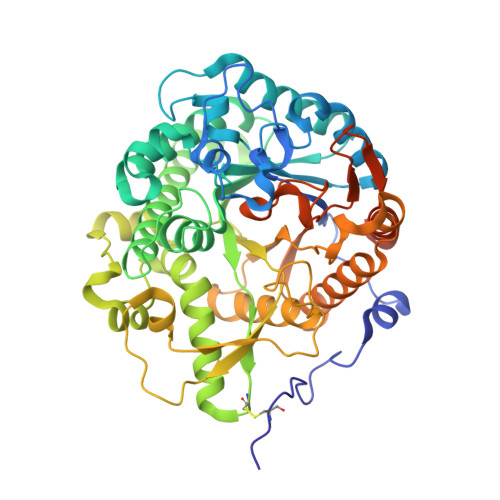Structural insight into a GH1 beta-glucosidase from the oleaginous microalga, Nannochloropsis oceanica.
Dong, S., Liu, Y.J., Zhou, H., Xiao, Y., Xu, J., Cui, Q., Wang, X., Feng, Y.(2021) Int J Biol Macromol 170: 196-206
- PubMed: 33347927
- DOI: https://doi.org/10.1016/j.ijbiomac.2020.12.128
- Primary Citation of Related Structures:
5YJ7 - PubMed Abstract:
Marine microalgae are promising sources of novel glycoside hydrolases (GHs), which have great value in biotechnical and industrial applications. Although many GH1 family β-glucosidases have been extensively studied, studies on β-glucosidases from microalgae are rare, and no structure of algal GH1 β-glucosidase has been reported. Here, we report the biochemical and structural study of a GH1 β-glucosidase BGLN1 from Nannochloropsis oceanica, an oleaginous microalga. Phylogenetic analysis of BGLN1, together with the known structures of GH1 β-glucosidases, has indicated that BGLN1 is branched at the root of the eukaryotic part of the phylogenetic tree. BGLN1 showed higher activity against laminaribiose compared to cello-oligosaccharides. Unlike most of the other GH1 β-glucosidases, BGLN1 is partially inhibited by metal ions. The crystal structure of BGLN1 revealed that BGLN1 adopts a typical (α/β) 8 -barrel fold with variations in loops and N-terminal regions. BGLN1 contains extra residues at the N-terminus, which are essential for maintaining protein stability. BGLN1 has a more acidic substrate-binding pocket than other β-glucosidases, and the variations beyond the conserved -1 site determine the substrate specificity. These results indicate that GH enzymes from microalgae may have unique structural and functional features, which will provide new insight into carbohydrate synthesis and metabolism in marine microalgae.
Organizational Affiliation:
CAS Key Laboratory of Biofuels, Qingdao Institute of Bioenergy and Bioprocess Technology, Chinese Academy of Sciences, Qingdao, Shandong 266101, China; Shandong Provincial Key Laboratory of Energy Genetics, Qingdao Institute of Bioenergy and Bioprocess Technology, Chinese Academy of Sciences, Qingdao, Shandong 266101, China; Shandong Engineering Laboratory of Single Cell Oil, Qingdao Institute of Bioenergy and Bioprocess Technology, Chinese Academy of Sciences, Qingdao, Shandong 266101, China; University of Chinese Academy of Sciences, Beijing 100049, China.
















